Molecular phylogeny of the Pseudallescheria boydii species complex: proposal of two new species
- PMID: 16207945
- PMCID: PMC1248451
- DOI: 10.1128/JCM.43.10.4930-4942.2005
Molecular phylogeny of the Pseudallescheria boydii species complex: proposal of two new species
Abstract
Pseudallescheria boydii (anamorph Scedosporium apiospermum) is the species responsible for human scedosporiosis, a fungal infection with a high mortality rate and which is difficult to treat. Recently, it has been demonstrated that high genetic variation exists within this species. We have performed a morphological and molecular study involving numerous strains of clinical or environmental origins and from different countries. The analysis of partial sequences of the beta-tubulin (two loci) and calmodulin genes and the internal transcribed spacer region of the rRNA gene has demonstrated that P. boydii is a species complex. The combined analysis of the sequences of the four loci of 60 strains has showed the presence of 44 haplotypes in the in group. Three species morphologically related to P. boydii sensu stricto, i.e., Pseudallescheria angusta, Pseudallescheria ellipsoidea, and Pseudallescheria fusoidea, which had previously been considered synonyms, could be differentiated genetically from P. boydii in our study. It is relevant that two of the three strains now included in P. ellipsoidea have caused invasive infections. The species Pseudallescheria minutispora and Scedosporium aurantiacum are clearly phylogenetically separated from the other species studied and are here proposed as new. Morphological features support this proposal. All the strains included in S. aurantiacum species have a clinical origin, while those included in P. minutispora are environmental. Further studies are needed to demonstrate whether all the species included in the P. boydii complex have different clinical spectra and antifungal susceptibility.
Figures
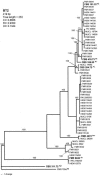

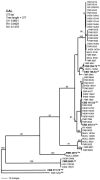
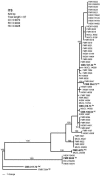
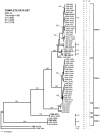
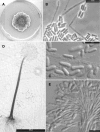
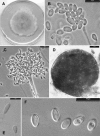
References
-
- Castiglioni, B., D. A. Sutton, M. G. Rinaldi, J. Fung, and S. Kusne. 2002. Pseudallescheria boydii (anamorph Scedosporium apiospermum) infection in solid organ transplant recipients in a tertiary medical center and review of the literature. Medicine 81:333-348. - PubMed
Publication types
MeSH terms
Substances
Associated data
- Actions
- Actions
- Actions
- Actions
- Actions
- Actions
- Actions
- Actions
- Actions
- Actions
- Actions
- Actions
- Actions
- Actions
- Actions
- Actions
- Actions
- Actions
- Actions
- Actions
- Actions
- Actions
- Actions
- Actions
- Actions
- Actions
- Actions
- Actions
- Actions
- Actions
- Actions
- Actions
- Actions
- Actions
- Actions
- Actions
- Actions
- Actions
- Actions
- Actions
- Actions
- Actions
- Actions
- Actions
- Actions
- Actions
- Actions
- Actions
- Actions
- Actions
- Actions
- Actions
- Actions
- Actions
- Actions
- Actions
- Actions
- Actions
- Actions
- Actions
- Actions
- Actions
- Actions
- Actions
- Actions
- Actions
- Actions
- Actions
- Actions
- Actions
- Actions
- Actions
- Actions
- Actions
- Actions
- Actions
- Actions
- Actions
- Actions
- Actions
- Actions
- Actions
- Actions
- Actions
- Actions
- Actions
- Actions
- Actions
- Actions
- Actions
- Actions
- Actions
- Actions
- Actions
- Actions
- Actions
- Actions
- Actions
- Actions
- Actions
- Actions
- Actions
- Actions
- Actions
- Actions
- Actions
- Actions
- Actions
- Actions
- Actions
- Actions
- Actions
- Actions
- Actions
- Actions
- Actions
- Actions
- Actions
- Actions
- Actions
- Actions
- Actions
- Actions
- Actions
- Actions
- Actions
- Actions
- Actions
- Actions
- Actions
- Actions
- Actions
- Actions
- Actions
- Actions
- Actions
- Actions
- Actions
- Actions
- Actions
- Actions
- Actions
- Actions
- Actions
- Actions
- Actions
- Actions
- Actions
- Actions
- Actions
- Actions
- Actions
- Actions
- Actions
- Actions
- Actions
- Actions
- Actions
- Actions
- Actions
- Actions
- Actions
- Actions
- Actions
- Actions
- Actions
- Actions
- Actions
- Actions
- Actions
- Actions
- Actions
- Actions
- Actions
- Actions
- Actions
- Actions
- Actions
- Actions
- Actions
- Actions
- Actions
- Actions
- Actions
- Actions
- Actions
- Actions
- Actions
- Actions
- Actions
- Actions
- Actions
- Actions
- Actions
- Actions
- Actions
- Actions
- Actions
- Actions
- Actions
- Actions
- Actions
- Actions
- Actions
- Actions
- Actions
- Actions
- Actions
- Actions
- Actions
- Actions
- Actions
- Actions
- Actions
- Actions
- Actions
- Actions
- Actions
- Actions
- Actions
- Actions
- Actions
- Actions
- Actions
- Actions
- Actions
- Actions
- Actions
- Actions
- Actions
- Actions
- Actions
- Actions
- Actions
- Actions
- Actions
- Actions
- Actions
- Actions
- Actions
- Actions
- Actions
- Actions
- Actions
- Actions
- Actions
- Actions
LinkOut - more resources
Full Text Sources

